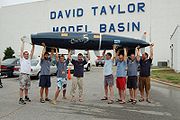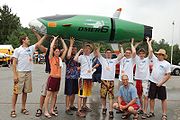.gif)
Omer (submarine)
Encyclopedia
Omer is the name of a series of human-powered
submarine
s. The submarines were built by students of the École de technologie supérieure
(School of Higher Technology) in Montreal
, Quebec
, for the International Submarine Races. , Omer teams hold the human-powered submarine world speed records for one-seater, two-seater, and non-propeller categories. Those records are :


Omer 6 is the latest generation of Omer submarine. Omer 6 uses its lateral wings' movement to gain speed. The constraint of the Omer 6 team was to use something other than a regular propeller in order to set the new world record in 'non-propeller' design.
In September 1995, the team decided that Omer would become the world's champion. With new members' ideas and older members' expertise, Omer 2 was born. In four months, a new hull was made and a new onboard computer was added to control the variable pitch from the propeller
, and to give some information to the pilot as well.
Omer went to California for a competition in May 1996, where it won a world record in the two-seater category. With that victory in hand, the team decided to aim for first place in the one-seater category. Construction on Omer 3 began.
The team found success in Washington in June 1997, winning world record in all categories. In the summer of 2001, Omer 4 was set to beat the previous world record of 7.192 knots. Since then, a new electrical control system has been tested and integrated for the 2002 competition in California.
Since their creation, Omer, Omer 2 and Omer 3 had a lot of visibility in the media, and gained offers of help from individuals and corporations.
In the summer of 2003, Omer 5, the new two-seater submarine took first place again using the experience acquired from Omer 4. The new submarine is now much more stable than Omer 4. In 2005, it beat the world speed record for a two-seater submarine setting the mark at 7.061 knots.
In the summer of 2007, the submarine Omer 5 set the new world record reaching a speed of 8.035 knots. Omer 6 a submarine using non-propeller reach 4.642 knots, with its driver Nicolas Tardif, setting also a world record for non-propeller submarine.
Two Person Propeller:
One Person Propeller:
One-Person, Non-Propeller:
Human-powered transport
Human-powered transport is the transport of person and/or goods using human muscle power. Like animal-powered transport, human-powered transport has existed since time immemorial in the form of walking, running and swimming...
submarine
Submarine
A submarine is a watercraft capable of independent operation below the surface of the water. It differs from a submersible, which has more limited underwater capability...
s. The submarines were built by students of the École de technologie supérieure
École de technologie supérieure
Founded in 1974, the École de technologie supérieure is part of the Université du Québec system. Specialized in applied teaching in engineering and technology transfer to companies, it teaches engineers and researchers who are recognized for their practical and innovative approach...
(School of Higher Technology) in Montreal
Montreal
Montreal is a city in Canada. It is the largest city in the province of Quebec, the second-largest city in Canada and the seventh largest in North America...
, Quebec
Quebec
Quebec or is a province in east-central Canada. It is the only Canadian province with a predominantly French-speaking population and the only one whose sole official language is French at the provincial level....
, for the International Submarine Races. , Omer teams hold the human-powered submarine world speed records for one-seater, two-seater, and non-propeller categories. Those records are :


- 7.192 knots for Omer 4 (one-seater)
- 8.035 knots for Omer 5 (two-seater)
- 4.642 knots for Omer 6 (one-seater / non-propeller)
Omer 6 is the latest generation of Omer submarine. Omer 6 uses its lateral wings' movement to gain speed. The constraint of the Omer 6 team was to use something other than a regular propeller in order to set the new world record in 'non-propeller' design.
History
Since 1992, a group of students from the É.T.S. in electrical, mechanical, software and automated automation engineering have taken part in the completion of Omer, a human-powered submarine. The first generation of Omer was a two-seater submarine that made its mark around the world. Despite the students' efforts and with numerous prizes and awards in conception and innovation, Omer was not the world's fastest submarine. Otherwise, at the first presence of the Omer team, a variable pitch system was operational and gave good performances and helped the next Omer submarines to increase their speed.In September 1995, the team decided that Omer would become the world's champion. With new members' ideas and older members' expertise, Omer 2 was born. In four months, a new hull was made and a new onboard computer was added to control the variable pitch from the propeller
Propeller
A propeller is a type of fan that transmits power by converting rotational motion into thrust. A pressure difference is produced between the forward and rear surfaces of the airfoil-shaped blade, and a fluid is accelerated behind the blade. Propeller dynamics can be modeled by both Bernoulli's...
, and to give some information to the pilot as well.
Omer went to California for a competition in May 1996, where it won a world record in the two-seater category. With that victory in hand, the team decided to aim for first place in the one-seater category. Construction on Omer 3 began.
The team found success in Washington in June 1997, winning world record in all categories. In the summer of 2001, Omer 4 was set to beat the previous world record of 7.192 knots. Since then, a new electrical control system has been tested and integrated for the 2002 competition in California.
Since their creation, Omer, Omer 2 and Omer 3 had a lot of visibility in the media, and gained offers of help from individuals and corporations.
In the summer of 2003, Omer 5, the new two-seater submarine took first place again using the experience acquired from Omer 4. The new submarine is now much more stable than Omer 4. In 2005, it beat the world speed record for a two-seater submarine setting the mark at 7.061 knots.
In the summer of 2007, the submarine Omer 5 set the new world record reaching a speed of 8.035 knots. Omer 6 a submarine using non-propeller reach 4.642 knots, with its driver Nicolas Tardif, setting also a world record for non-propeller submarine.
2007 results
Carderock, Maryland, June 28, 2007 – Speed results by division in the 9th International Submarine Races held June 25–29 at the Naval Surface Warfare Center's Carderock Division David Taylor Model Basin in Bethesda, Maryland:Two Person Propeller:
- 8.035 knots, OMER 5, École de technologie supérieur, University of Quebec
- 4.795 knots, F-A-U Boat , Florida Atlantic University
- 4.775 knots, Drekar, Western Washington University
- 4.043 knots, Sub Taxi, Independent
One Person Propeller:
- 6.473 knots, Archimede 4, École Polytechnique de Montreal
- 5.022 knots, Maroon Harpoon, Texas A&M
- 4.958 knots, Mercury, University of Michigan
- 4.835 knots, Sublime, Hernando County Schools, Spring Hill, Florida
- 3.771 knots, Phantom 5, Virginia Tech
- 3.488 knots, Sea Wolf, Hernando County Schools
- 2.343 knots, Dive Dawg, University of Washington
- 2.262 knots, Swamp Thing, University of Florida
- 1.694 knots, U-3.2, Sussex Technical High School, New Jersey
- 1.285 knots, RSR Fourier, University of Maryland
- 0.505 knots, Sea Car, Don Burton, Independent
One-Person, Non-Propeller:
- 4.642 knots, OMER 6, École de technologie supérieur, University of Quebec
- 2.092 knots, Sea Bomb, University of Bath, UK
- 2.035 knots, Sebastion, University of California San Diego
- 0.854 knots, Bogus Batoid, Bruce Plazyk, Independent
- 0.499 knots, Battlin' Pete, U.S. Merchant Marine Academy

